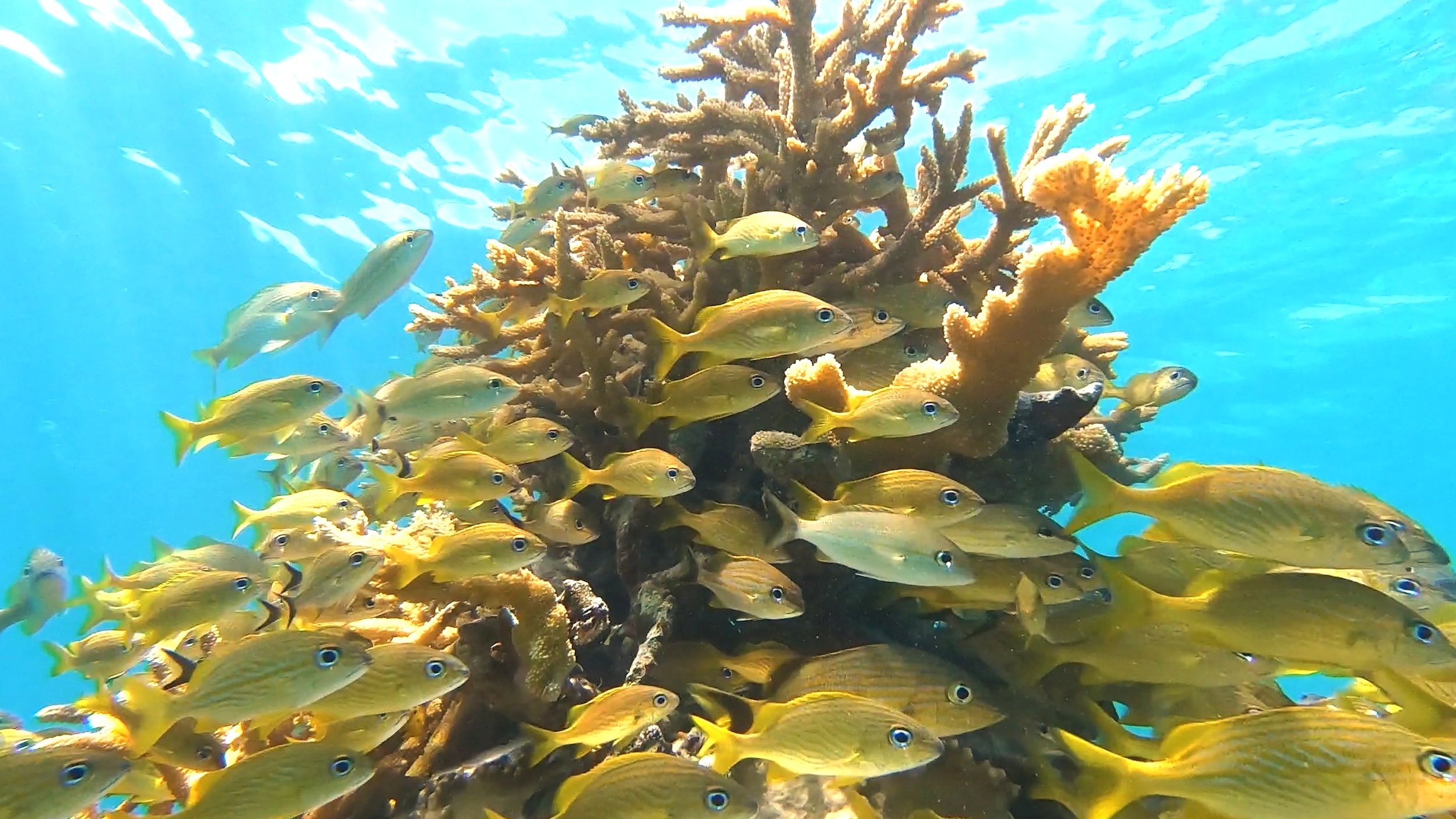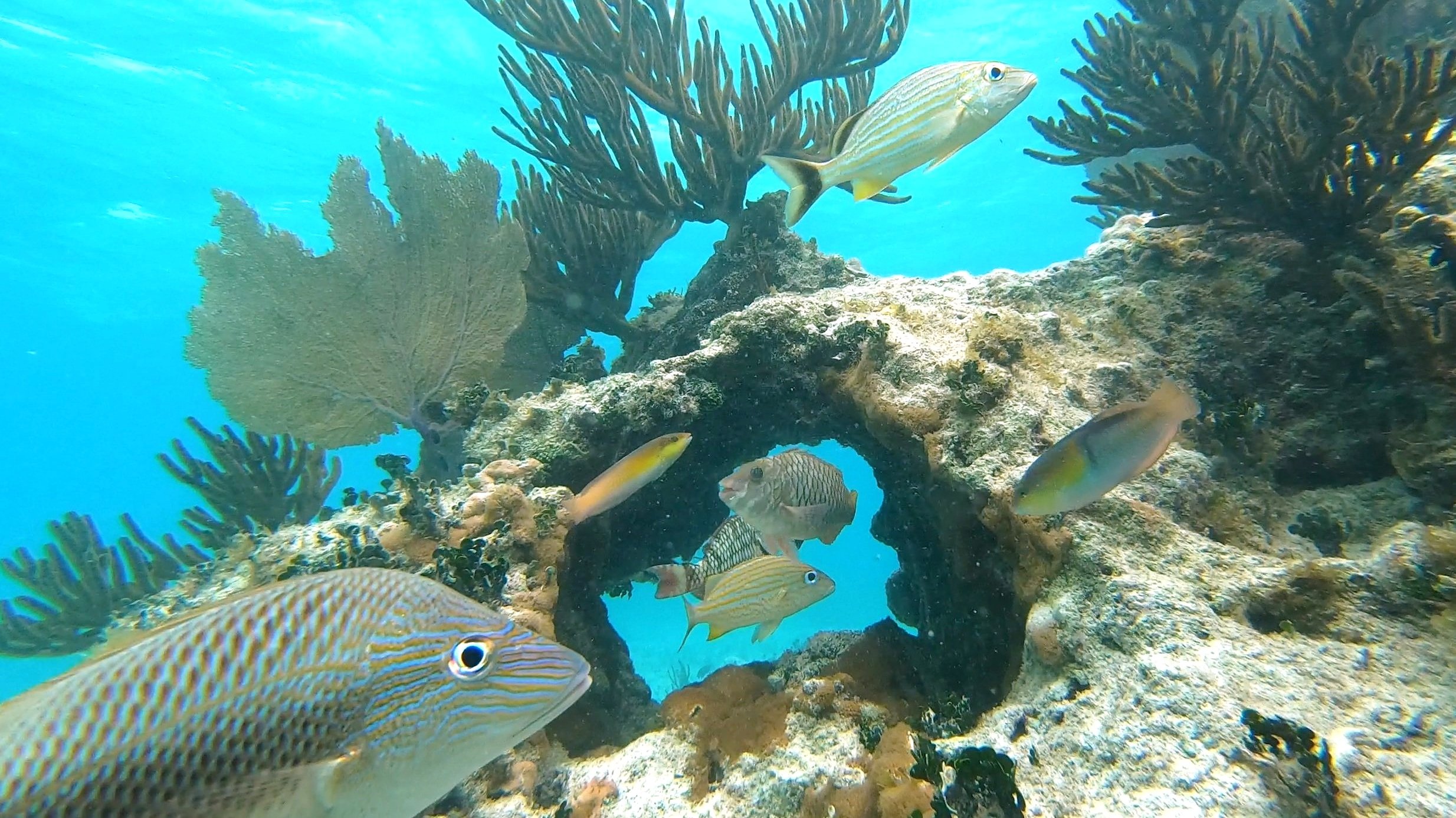Freediving Isla Mujeres, Isla Tiburon Reef
Isla Tiburon Reef of Isla Mujeres, Mexico by Andre Navarro
Once you’ve visited Isla Mujeres, the gorgeous Mexican Caribbean, you’ll never forget the name of this paradise island ! But have you heard of Isla Tiburon ? Chances are, if you’ve taken the local snorkeling tour, you actually visited it without knowing. And that ferry ride to Isla Mujeres that everyone takes, passes right by it’s northern tip. Isla Tiburon is a protected mini island, part of the larger Isla Mujeres, separated by a small channel on it’s southern side. To it’s east, is a large bay used for docking boats. Like larger Isla Mujeres, Isla Tiburon is long and thin, stretching lengthwise from North to South.
Isla Tiburon is Spanish for Shark Island ! But I’ve yet to see a shark anywhere near it. Maybe it’s shaped like a shark looking down ? Aside from it’s dramatic shark name, it’s surrounded with diverse and beautiful marine life ! Isla Tiburon has retained it’s natural thriving beauty above and below the surface by being isolated and not easily accessible. On Isla Tiburon’s west side, which faces Cancun, is a rocky shallow reef featuring many critically endangered corals and thousands of vibrant fish. It’s east side, which faces larger Isla Mujeres, is an amazing mangrove filled with sea grass, jelly fish and lots of cool boat wrecks. In this adventure, we’re going to focus on the shallow rocky reefs to it’s west.
South end of Isla Tiburon, Mexico by Andre Navarro
Starting from the southern tip of Isla Tiburon, you might recognize a popular glamorous house, built right on the reef across the channel. All the snorkeling tours pass by it and claim a wealthy owner of a large beer company owns it. Crossing over from this channel is very dangerous. There are boats constantly speeding through it in both directions and you can barely see around the bends. To make things even more challenging, aside from not getting hit by boats, the water is rushing through the channel like a river depending on the direction of the current. I have also accessed Isla Tiburon by kayak, which we paddled across the bay from Playa el Cocal. This was a very frustrating task as the kayak was not made for the ocean and kept turning in circles on every little wave, current and gust of wind. Paddling it straight across the bay was almost impossible.
The most common way to access Isla Tiburon is by the local snorkeling tours. One of the popular drop off areas is along the reef side over coral reefs made of cement pots. This area is teeming with hundreds of fish along with critically endangered corals making a come back. The snorkeling tours usually also visit a nearby sunken boat surrounded by fish at the northern end of Isla Tiburon. Then they go on to an area called El Farito also known as the Lighthouse Reef. Unfortunately, this area has been ruined by all the snorkeling tour boats and people touching everything. What is left at El Farito is sad and what happens when there is no common sense of the snorkeling tour providers combined with reckless people visiting. However, even though it’s only about 100 yards away from the ruined El Farito Reef, Isla Tiburon remains pristine !
Isla Mujeres reef house by Andre Navarro
The man made concrete pot looking habitats are a huge success. They’re topped with critically endangered Staghorn and Elkhorn Corals and are swarmed with hundreds of fish. Along the reef side of Isla Tiburon, there are many of these coral reef pots installed in sections. These sections usually contain 5 to 6 pots placed in a line, about 4 feet apart from each other, starting 50 feet out from the shore reef. There are 4 to 5 installments of these type sections every 50 yards or so starting mid island. Some of them are so overgrown by corals, you can’t even see the pots underneath. Most sections are inhabited by hundreds of fish, mostly French Grunts and Sergeant Majorfish. You’ll also experience a huge variety of other fish, like Parrotfish, Angelfish, Puffers, Surgeonfish and Snappers.
Man made coral reefs of Isla Mujeres, Mexico by Andre Navarro
Critically endangered Staghorn Coral of Isla Mujeres by Andre Navarro
Staghorn Coral and French Grunts of Isla Mujeres by Andre Navarro
There is a huge section of critically endangered Elkhorn Corals around mid island. I love this area because you can see where they once flourished and then died off. However, they are making a comeback here, overgrowing the original locations and spreading everywhere nearby. There is one corner in the shore reef where there are about 30 to 40 separate Elkhorn Corals thriving, from recent smaller sections, to older and huge branching corals. Elkhorn Corals grow 2 to 5 inches in branch length per year, up to a maximum size at 10 to 12 years. Staghorn Corals are the fastest growing corals in the area, with a growth rate of 4 to 8 inches per year. And of course these coral areas are filled with vibrant and diverse Caribbean fish.
Critically Endangered Elkhorn Coral of Isla Mujeres by Andre Navarro
Elkhorn Coral reef life of Isla Mujeres, Mexico by Andre Navarro
Along with Staghorn and Elkhorn Corals, this reef is rich with Critically Endangered Blade Fire Corals. Blade Fire Corals grow in upright plates or blades to about 20 inches. If you come in contact with these corals to your skin, you will get a severe stinging sensation, possibly resulting later in a rash. Blade Fire Corals are usually found near the surface along the shallow reef. You’ll find many smaller juvenile fish swimming around these corals along with Moray Eels hiding in the crevices.
Aside from critically endangered Elkhorn, Staghorn and Blade Fire Corals, you’ll also find many other common corals spread all over the reef. The most common corals you’ll find everywhere here are Caribbean Sea Whips, Bipinnate Sea Plumes and Purple Sea Fans. All resemble underwater plants of some sort, but like all corals, they are actually animals. I love exploring the many corals of this reef as much, if not more than the fish.
Critically endangered Blade Fire Coral of Isla Mujeres by Andre Navarro
Caribbean Sea Whip, Pilar and Mustard Hill Corals of Isla Mujeres by Andre Navarro
Caribbean Sea Whips of Isla Mujeres, Mexico by Andre Navarro
Of my more memorable ocean life experiences here, one oddly involves a bird. As I was exploring crevices in the reef while following some beautiful Gray and French Angelfish, I saw something quickly swim under the reef as fish came darting out. I thought maybe it was a small shark as I was confused. Then out comes this funny swimming Neotropic Cormorant. It swam funny, but fast. So fast, I could not keep up. And it could hold it’s breathe way longer than I could. It didn’t care about my presence either, at one point swimming around me as I was in it’s way. Of the many things I was expecting to see this day, a bird swimming all over the reef was not one of them.
My other favorite ocean life experience was coming across this huge Spotfin Porcupinefish under the reef. We had barely began exploring from the south side of Isla Tiburon when I dove down to look into some crevices under the reef. Immediately I came face to face with this huge cute Spotfin Porcupinefish with it’s big round eyes looking at me. I’m not sure who was more surprised, but we couldn’t stop staring at each other. I love coming across big porcupinefish and puffers. The bigger the better.
Neotropic Cormorant of Isla Mujeres by Andre Navarro
French Angelfish of Isla Mujeres by Andre Navarro
Gray Angelfish of Isla Mujeres by Andre Navarro
Spotfin Porcupinefish of Isla Mujeres by Andre Navarro
The entire reef side of Isla Tiburon is filled with gorgeous views, from above and below the surface. It’s seclusion adds to it’s serenity. Every so often a boat passes by, but other than that, there is almost no one else there. From the beautiful turquoise water to the clean light blue sky. From the shore reef bordered by lush green bushes to the amazing underwater environment ranging from rocky coral reefs, to fields of sea grass and corals, all teeming with vibrant Caribbean fish. It feels like a secret paradise that you never want to leave.
But once you dive down, you enter an entirely different world. One that is important to share because it needs to be preserved. Even though the main island of Isla Mujeres is visited by many people, I would estimate more than 3/4 are not aware of the amazing ocean life surrounding it. If you are not aware of something that needs attention to conserve, you can’t make the better decisions that benefit it.
Exploring the beautiful reef life here is like living in nature’s art. It helps that the fish are not very skittish either making them easy to observe. The yellow with black stripes Sergeant Majorfish along with silver Bermuda Chubs are extremely friendly and curious. When I swim by these fish, they often follow me like a fishy entourage. When you find popular fish spots, usually around corals and rocky reefs with crevices, there is an abundance of diverse and colorful fish.
Vibrant fish of Isla Mujeres, Mexico by Andre Navarro
Shallow shore reef of Isla Mujeres by Andre Navarro
Bluestriped Grunt of Isla Mujeres, Mexico by Andre Navarro
Isla Tiburon is definitely one of my favorite spots to explore the amazing ocean life of Isla Mujeres. I can spend days here slowly capturing all the underwater views that this gorgeous island has to offer. The water temperature if perfect where you don’t have to wear a wetsuit to keep warm. Which also helps conserve energy to be able to explore longer. After hours of adventuring and observing, I feel sad when it’s time to leave. Usually by this time, I’m exhausted and starving, but I miss the reef even before I’ve left. It’s like ending a beautiful dream you never want to end.
The accompanying Youtube videos are first hand footage captured by Andre Navarro while freedive exploring Isla Tiburon of Isla Mujeres, Mexico. You can also view hundreds of beautiful photos of the awesome ocean life and underwater environments of Isla Mujeres in the Photos section, Images of Isla Mujeres, MexicoPublished by: Andre Navarro of Ocean Earth Green
I’m Andre Navarro, Southern California freediver and underwater videographer. I create ocean life adventure videos to connect viewers to our amazing underwater world to motivate stronger conservation and ocean life awareness. You can follow my ocean adventures here at OceanEarthGreen.com and view all my current and past videos at Youtube.com/OceanEarthGreen.

















